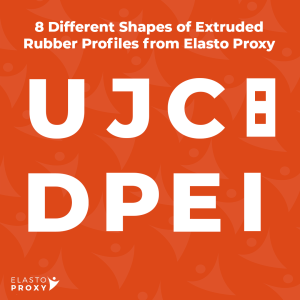![]() When is silicone rubber the right choice for sealing and insulation? Silicones have many desirable properties, but can cost more than other polymers. That’s why some engineers avoid them – even though silicone prices have fallen. At the same time, newer materials such as thermoplastic elastomers (TPE) are interesting but even more expensive.
When is silicone rubber the right choice for sealing and insulation? Silicones have many desirable properties, but can cost more than other polymers. That’s why some engineers avoid them – even though silicone prices have fallen. At the same time, newer materials such as thermoplastic elastomers (TPE) are interesting but even more expensive.
If you’re wondering whether silicone rubber is the right choice for your application, Elasto Proxy invites you to take a fresh look at these synthetic elastomers. In Part 1 of this two-part series, we’ll examine the advantages of silicone rubber, cover some basic chemistry, and then focus on silicone gasket materials. Next, we’ll categorize silicones in different ways so that you’ll be ready to understand the applications.
Advantages of Silicones
Silicones resist moisture, chemicals, heat, cold, ozone, and ultraviolet (UV) radiation. They’re also stable, flexible, long-lasting, and aesthetically-pleasing. The advantages of silicone rubber include:
- Good thermal stability and low chemical reactivity
- Excellent resistance to ozone, sunlight, and oxygen
- Consistent properties at high and low temperatures
- Repels water, resists moisture, and forms watertight seals
- Good electrical insulation and excellent gas permeability
- Come in a range of durometers and custom colors
- Available in special grades and with filler materials
Silicone Chemistry
![]() Silicones are a family of polymers that are produced by reacting silicon with methyl chloride. Further reaction with water removes the chlorine and imparts resistance to both high and low temperatures. Because of silicone’s molecular structure, these polymers are available not only as solids, but also as semi-viscous pastes, greases, and liquids. Solid silicones require curing and use different cross-linking reactions.
Silicones are a family of polymers that are produced by reacting silicon with methyl chloride. Further reaction with water removes the chlorine and imparts resistance to both high and low temperatures. Because of silicone’s molecular structure, these polymers are available not only as solids, but also as semi-viscous pastes, greases, and liquids. Solid silicones require curing and use different cross-linking reactions.
Silicone Gasket Materials
For engineers, it’s important to understand that silicones can be divided into various types, classes, and industrial classifications. Note that “solid” materials also include silicone rubber with a cellular or foamed structure. These silicone profiles, sheets, and rolls support water jet cutting, splicing, taping, and other processes used in gasket fabrication.
Solid, Sponge, and Foam Silicones
There are three basic types of silicone gasket materials: solid, sponge, and foam.
- Solid silicone gaskets have a tightly-packed molecular structure. They aren’t always “soft”, but they can have a lower durometer (hardness) than sponge silicone. Lower-durometer solid profiles provide strong environmental sealing with low closure force. Higher durometers require greater closure force.
- Sponge silicone gaskets have a cellular structure that offers cushioning and padding. There are two basic types of sponge silicones: open-cell and closed-cell. Open-cell silicones contain interconnected pockets that allow water, air, and chemicals to pass unless the gasket is compressed. Closed-cell silicones have pockets that are filled with nitrogen to prevent these substances from passing at low pressures.
- Foam silicone gaskets are available in soft, medium, firm, and extra-firm grades for different amounts of compressibility. Foam silicones offer improved flame resistance, too. There are three varieties of silicone foams: open-cell, closed-cell, and foamed materials with both open cells and closed cells.
Special Grades and Filler Materials
Silicone gasket materials are available in grades that meet FDA requirements, UL 94 standards, and military and aerospace requirements. They can also contain filler materials to add strength, or to provide shielding against electromagnetic interference (EMI).
- FDA silicone gaskets meet U.S. Food and Drug Administration (FDA) requirements for food contact applications and medical devices.
- UL 94 silicone gaskets meet testing requirements from Underwriters Laboratories (UL) for fire safety and flame resistance.
- EMI silicone gaskets that contain metal or metal-coated particles can meet MIL-DTL-8352 shielding requirements from the U.S. Department of Defense (DoD).
- High flex-fatigue resistance gaskets can also meet military and aerospace requirements. They resist cracking during repeated take-offs and landings.
- Fluorosilicone gaskets contain fluorine additions for added chemical and fuel resistance. They can also contain metal or metal-coated particles for EMI shielding.
Silicone Rubber Gaskets for Your Application
In Part 2 of this series, we’ll look at some common applications for silicone gaskets. If you need more information before then, please contact Elasto Proxy.











